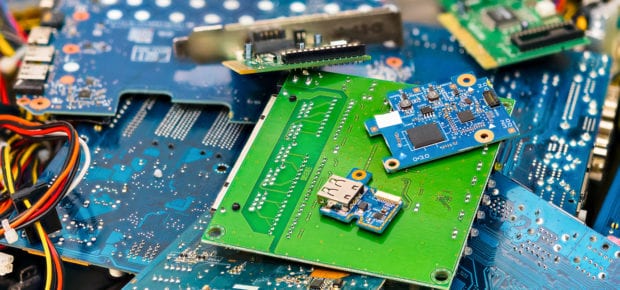July 29, 2019
As technology advances rapidly, the question of how to sustainably manufacture new products and how to dispose of old ones are both of increasing importance.
After all, the average lifespan of devices is shrinking, and the United Nations is projecting that people will generate 52.2 million metric tons of e-waste globally by 2021.
New Opportunities
When we talk about our waste problem with experts in the IEEE community, a recurring idea is that these resourcing questions present a series of opportunities to innovate in other ways.
Kaikai Xu, IEEE Senior member, Professor at the University of Electronic Science and Technology of China, is adamant on this front: “Opportunities often coexist with challenges,” he says.
An example on Xu’s mind? “We will save a lot of energy and materials if we can reduce the power consumption and size of chips in the semiconductor industry, as there is a huge demand for electronic products all over the world. There will be a huge market for the design of low-power chips.”
For Paige Kassalan, IEEE Graduate Student member, “One industry that has a lot of opportunity is building and construction. For Solar Impulse, we had very efficient insulation to keep the pilots in a bearable temperature at 8.5km. That insulation is now used in refrigerators to allow for less energy to be lost.”
Through advances in research and manufacturing, we can decrease the amount of material needed to produce items (meaning less waste), as well as make those items more efficient (meaning less energy use).
Already, smart manufacturing is developing rapidly. The concept revolves around using an integrated computing platform that encompasses the full production process – engineering, manufacturing and delivery. By creating a holistic set of data, efficiency can be greatly improved.
Using Sensors and Data
Sensors, data and software have roles to play both in manufacturing and waste disposal.
Disposing of waste has long been a complex issue. After all, no one wants to live near a landfill, or to have other people’s trash brought into their neighborhood. The issue gets exacerbated as electronic materials like chips, batteries and screens enter the waste stream.
As a result, “Waste management and disposal continues to increase in costs while trying to adhere to tighter constraints to remain environmentally sustainable,” says Karen Panetta, IEEE Fellow and Dean of Graduate Education at Tufts University
Environmental regulation and cost pressures are helping drive innovation in making technologies smaller, as well as making the production process less wasteful. While this stands to improve the future, there’s still the question of disposing of many outdated electronics, which can be hazardous if handled improperly.
To address health concerns, Panetta says, “some of the newest technological advances are utilizing low-cost sensor technologies and wireless communications to measure the decay in landfills and to monitor waste flow in open water and the effects on wildlife, humans and the environment.”
By using sensors to get tangible numbers, it becomes easier to make better policy decisions when it comes to waste, according to Panetta. And that doesn’t just apply to sites that contain e-waste – it’s also applicable to all types of landfill contents, as well as local infrastructure like drinking water.
“For instance,” Panetta says, “consider the water quality issues that plagued cities in Michigan. Engineers took the initiative to collect the data, work with residents to conduct the water testing and proved to the municipality that there was a true health issue, which contradicted the municipality’s position. The results and conclusions from this data science approach were indisputable.”
Further Reading
For more on making consumer communications technologies more sustainable and reducing e-waste, read our interview with IEEE Senior member Charles Despins.
To hear about advances in environmental sensors, take a look at our Q&A with IEEE member Yoshinori Matsumoto.
And for more on broader efforts in environmental sustainability, check out our series on global innovation and the environment.





 Meaningful Momentum or Running in Place?
Meaningful Momentum or Running in Place? AI Through Our Ages
AI Through Our Ages Liquid Infrastructure: Our Planet's Most Precious Resource
Liquid Infrastructure: Our Planet's Most Precious Resource The Impact of Technology in 2025
The Impact of Technology in 2025 Quantum and AI: Safeguards or Threats to Cybersecurity?
Quantum and AI: Safeguards or Threats to Cybersecurity? Why AI Can't Live Without Us
Why AI Can't Live Without Us Bits, Bytes, Buildings and Bridges: Digital-Driven Infrastructure
Bits, Bytes, Buildings and Bridges: Digital-Driven Infrastructure Impact of Technology in 2024
Impact of Technology in 2024 Emerging AI Cybersecurity Challenges and Solutions
Emerging AI Cybersecurity Challenges and Solutions The Skies are Unlimited
The Skies are Unlimited Smart Cities 2030: How Tech is Reshaping Urbanscapes
Smart Cities 2030: How Tech is Reshaping Urbanscapes Impact of Technology 2023
Impact of Technology 2023 Cybersecurity for Life-Changing Innovations
Cybersecurity for Life-Changing Innovations Smarter Wearables Healthier Life
Smarter Wearables Healthier Life Infrastructure In Motion
Infrastructure In Motion The Impact of Tech in 2022 and Beyond
The Impact of Tech in 2022 and Beyond Cybersecurity, Technology and Protecting Our World
Cybersecurity, Technology and Protecting Our World How Technology Helps us Understand Our Health and Wellness
How Technology Helps us Understand Our Health and Wellness The Resilience of Humanity
The Resilience of Humanity Harnessing and Sustaining our Natural Resources
Harnessing and Sustaining our Natural Resources Creating Healthy Spaces Through Technology
Creating Healthy Spaces Through Technology Exceptional Infrastructure Challenges, Technology and Humanity
Exceptional Infrastructure Challenges, Technology and Humanity The Global Impact of IEEE's 802 Standards
The Global Impact of IEEE's 802 Standards Scenes of our Cyber Lives: The Security Threats and Technology Solutions Protecting Us
Scenes of our Cyber Lives: The Security Threats and Technology Solutions Protecting Us How Millennial Parents are Embracing Health and Wellness Technologies for Their Generation Alpha Kids
How Millennial Parents are Embracing Health and Wellness Technologies for Their Generation Alpha Kids Space Exploration, Technology and Our Lives
Space Exploration, Technology and Our Lives Global Innovation and the Environment
Global Innovation and the Environment How Technology, Privacy and Security are Changing Each Other (And Us)
How Technology, Privacy and Security are Changing Each Other (And Us) Find us in booth 31506, LVCC South Hall 3 and experience the Technology Moon Walk
Find us in booth 31506, LVCC South Hall 3 and experience the Technology Moon Walk Virtual and Mixed Reality
Virtual and Mixed Reality How Robots are Improving our Health
How Robots are Improving our Health IEEE Experts and the Robots They are Teaching
IEEE Experts and the Robots They are Teaching See how millennial parents around the world see AI impacting the lives of their tech-infused offspring
See how millennial parents around the world see AI impacting the lives of their tech-infused offspring Take the journey from farm to table and learn how IoT will help us reach the rising demand for food production
Take the journey from farm to table and learn how IoT will help us reach the rising demand for food production Watch technical experts discuss the latest cyber threats
Watch technical experts discuss the latest cyber threats Explore how researchers, teachers, explorers, healthcare and medical professionals use immersive technologies
Explore how researchers, teachers, explorers, healthcare and medical professionals use immersive technologies Follow the timeline to see how Generation AI will be impacted by technology
Follow the timeline to see how Generation AI will be impacted by technology Learn how your IoT data can be used by experiencing a day in a connected life
Learn how your IoT data can be used by experiencing a day in a connected life Listen to technical experts discuss the biggest security threats today
Listen to technical experts discuss the biggest security threats today See how tech has influenced and evolved with the Games
See how tech has influenced and evolved with the Games Enter our virtual home to explore the IoT (Internet of Things) technologies
Enter our virtual home to explore the IoT (Internet of Things) technologies Explore an interactive map showcasing exciting innovations in robotics
Explore an interactive map showcasing exciting innovations in robotics Interactively explore A.I. in recent Hollywood movies
Interactively explore A.I. in recent Hollywood movies Get immersed in technologies that will improve patients' lives
Get immersed in technologies that will improve patients' lives